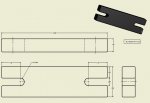I have a rectangle L=13.6"
W=3.7" L*W= 50.32"
I subtract a cutout with an area of 6.45 "
Total area is now 43.8697"
V= [(L*W)-slot area]*H...(height is 2.175")
Mass is 25lbs
Density is 0.262
I know that Vol* Density=Mass
I don't know how to arrange this information so there is a single formula that will automatically correct the height if the mass is change...
W=3.7" L*W= 50.32"
I subtract a cutout with an area of 6.45 "
Total area is now 43.8697"
V= [(L*W)-slot area]*H...(height is 2.175")
Mass is 25lbs
Density is 0.262
I know that Vol* Density=Mass
I don't know how to arrange this information so there is a single formula that will automatically correct the height if the mass is change...



